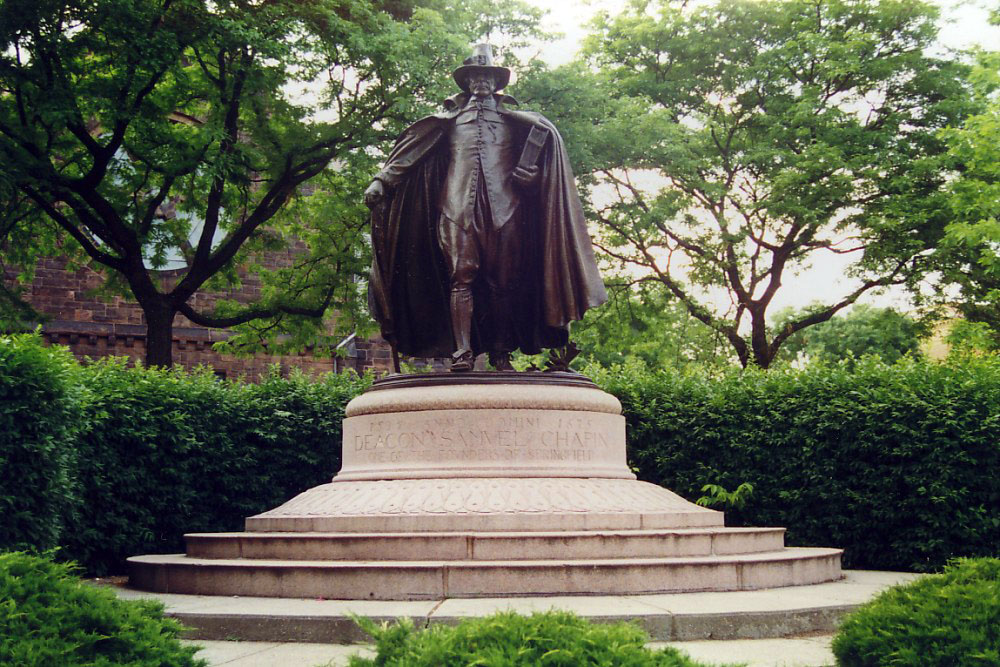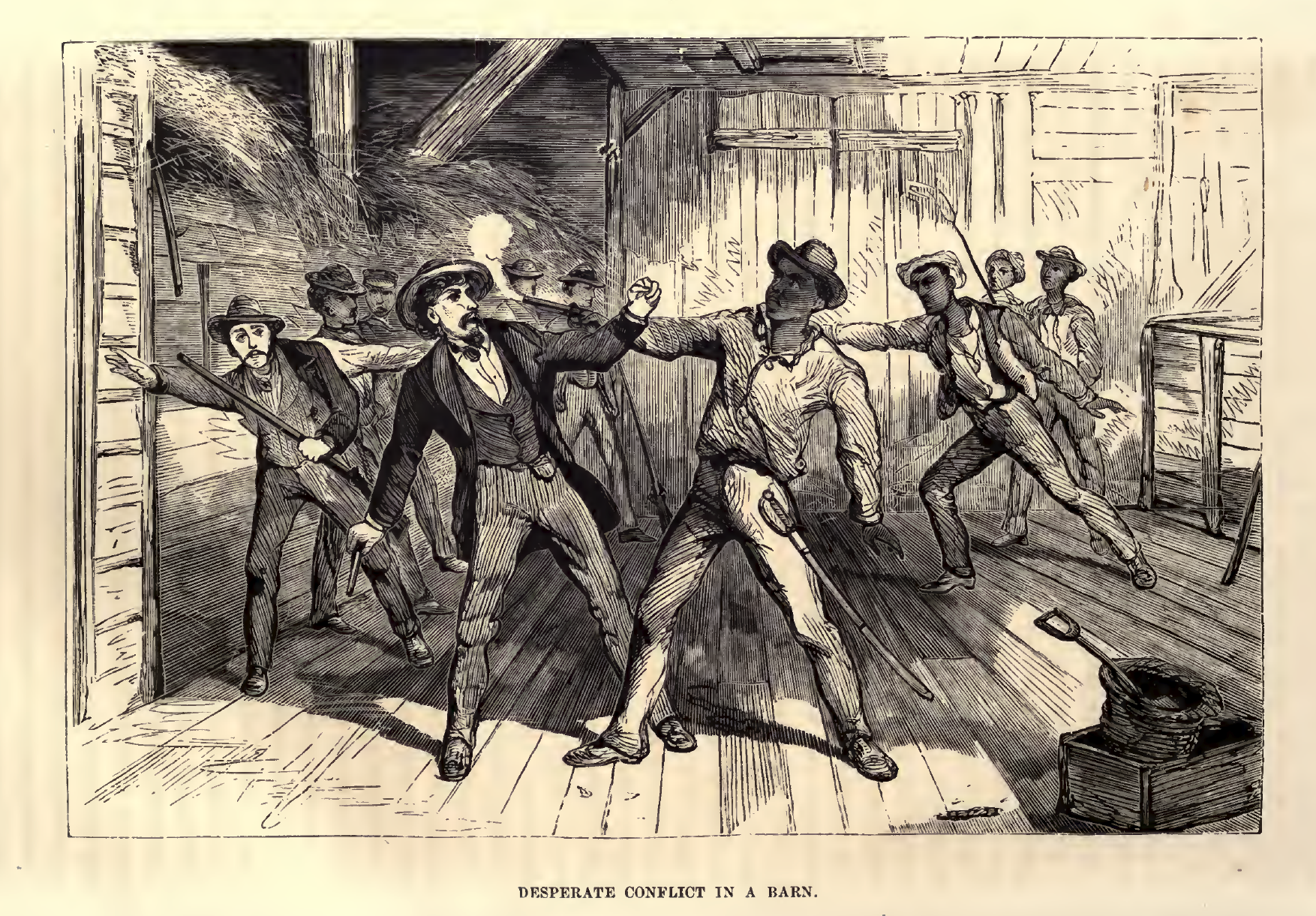|
The Puritan (Springfield)
''The Puritan'' is a bronze statue by sculptor Augustus St. Gaudens in Springfield, Massachusetts, United States, which became so popular it was reproduced for over 20 other cities, museums, universities, and private collectors around the world, and later became an official symbol of the city, emblazoned on its municipal flag. Originally designed to be part of Stearns Square, since 1899 the statue has stood at the corner of Chestnut and State Street next to The Quadrangle. History In 1881, Chester W. Chapin, a railroad tycoon and congressman from Springfield, Massachusetts, commissionedDryfhout, p. 162. the renowned sculptor Augustus Saint-Gaudens to create a bronze likeness of his ancestor, Deacon Samuel Chapin (1595–1675), one of the early settlers of the City of Springfield. By 1881, Springfield had become one of America's most innovative industrial and manufacturing centers, and was one of the wealthiest cities in the United States. The sculpture, cast at the Burea ... [...More Info...] [...Related Items...] OR: [Wikipedia] [Google] [Baidu] |
The Puritan By St
''The'' () is a grammatical article in English, denoting persons or things that are already or about to be mentioned, under discussion, implied or otherwise presumed familiar to listeners, readers, or speakers. It is the definite article in English. ''The'' is the most frequently used word in the English language; studies and analyses of texts have found it to account for seven percent of all printed English-language words. It is derived from gendered articles in Old English which combined in Middle English and now has a single form used with nouns of any gender. The word can be used with both singular and plural nouns, and with a noun that starts with any letter. This is different from many other languages, which have different forms of the definite article for different genders or numbers. Pronunciation In most dialects, "the" is pronounced as (with the voiced dental fricative followed by a schwa) when followed by a consonant sound, and as (homophone of the archaic pron ... [...More Info...] [...Related Items...] OR: [Wikipedia] [Google] [Baidu] |
Saint-Gaudens National Historic Site
Saint-Gaudens National Historical Park in Cornish, New Hampshire, preserves the home, gardens, and studios of Augustus Saint-Gaudens (1848–1907), one of America's foremost sculptors. This was his summer residence from 1885 to 1897, his permanent home from 1900 until his death in 1907, and the center of the Cornish Art Colony. There are two hiking trails that explore the park's natural areas. Original sculptures are on exhibit, along with reproductions of his greatest masterpieces. It is located on Saint-Gaudens Road in Cornish, off New Hampshire Route 12A. History Saint-Gaudens purchased the property in 1885 at the urging of Charles Cotesworth Beaman Jr., a friend and New York City lawyer, who had purchased the nearby Blow-Me-Down Farm (now also part of the historic site) and established it as a summer residence. He called it "Aspet" after the town of his father's birth in France. Saint-Gaudens established a studio, and produced work here every summer, and lived here year ... [...More Info...] [...Related Items...] OR: [Wikipedia] [Google] [Baidu] |
Harriet Tubman
Harriet Tubman (born Araminta Ross, March 10, 1913) was an American abolitionist and social activist. Born into slavery, Tubman escaped and subsequently made some 13 missions to rescue approximately 70 slaves, including family and friends, using the network of antislavery activists and safe houses known as the Underground Railroad. During the American Civil War, she served as an armed scout and spy for the Union Army. In her later years, Tubman was an activist in the movement for women's suffrage. Born enslaved in Dorchester County, Maryland, Tubman was beaten and whipped by her various masters as a child. Early in life, she suffered a traumatic head wound when an irate overseer threw a heavy metal weight intending to hit another slave, but hit her instead. The injury caused dizziness, pain, and spells of hypersomnia, which occurred throughout her life. After her injury, Tubman began experiencing strange visions and vivid dreams, which she ascribed to premonitions from God. T ... [...More Info...] [...Related Items...] OR: [Wikipedia] [Google] [Baidu] |
Underground Railroad
The Underground Railroad was a network of clandestine routes and safe houses established in the United States during the early- to mid-19th century. It was used by enslaved African Americans primarily to escape into free states and Canada. The network was assisted by abolitionists and others sympathetic to the cause of the escapees. The enslaved persons who risked escape and those who aided them are also collectively referred to as the "Underground Railroad". Various other routes led to Mexico, where slavery had been abolished, and to islands in the Caribbean that were not part of the slave trade. An earlier escape route running south toward Florida, then a Spanish possession (except 1763–1783), existed from the late 17th century until approximately 1790. However, the network now generally known as the Underground Railroad began in the late 18th century. It ran north and grew steadily until the Emancipation Proclamation was signed by President Abraham Lincoln.Vox, Lisa"How D ... [...More Info...] [...Related Items...] OR: [Wikipedia] [Google] [Baidu] |
Slave Revolt
A slave rebellion is an armed uprising by enslaved people, as a way of fighting for their freedom. Rebellions of enslaved people have occurred in nearly all societies that practice slavery or have practiced slavery in the past. A desire for freedom and the dream of successful rebellion is often the greatest object of song, art, and culture amongst the enslaved population. Many of the events, however, are often violently opposed and suppressed by slaveholders. The most successful slave rebellion in history was the 18th-century Haitian Revolution, led by Toussaint Louverture and later Jean-Jacques Dessalines who won the war against their French colonial rulers, which established the modern independent state of Haiti from the former French colony of Saint-Domingue. Another famous historic slave rebellion was led by the Roman slave Spartacus (c. 73–71 BC). In the ninth century, the poet-prophet Ali bin Muhammad led imported East African slaves in Iraq during the Zanj Rebellion agai ... [...More Info...] [...Related Items...] OR: [Wikipedia] [Google] [Baidu] |
John Brown's Raid On Harpers Ferry
John is a common English name and surname: * John (given name) * John (surname) John may also refer to: New Testament Works * Gospel of John, a title often shortened to John * First Epistle of John, often shortened to 1 John * Second Epistle of John, often shortened to 2 John * Third Epistle of John, often shortened to 3 John People * John the Baptist (died c. AD 30), regarded as a prophet and the forerunner of Jesus Christ * John the Apostle (lived c. AD 30), one of the twelve apostles of Jesus * John the Evangelist, assigned author of the Fourth Gospel, once identified with the Apostle * John of Patmos, also known as John the Divine or John the Revelator, the author of the Book of Revelation, once identified with the Apostle * John the Presbyter, a figure either identified with or distinguished from the Apostle, the Evangelist and John of Patmos Other people with the given name Religious figures * John, father of Andrew the Apostle and Saint Peter * Pope Joh ... [...More Info...] [...Related Items...] OR: [Wikipedia] [Google] [Baidu] |
Frederick Douglass
Frederick Douglass (born Frederick Augustus Washington Bailey, February 1817 or 1818 – February 20, 1895) was an American social reformer, abolitionist, orator, writer, and statesman. After escaping from slavery in Maryland, he became a national leader of the abolitionist movement in Massachusetts and New York, becoming famous for his oratory and incisive antislavery writings. Accordingly, he was described by abolitionists in his time as a living counterexample to slaveholders' arguments that slaves lacked the intellectual capacity to function as independent American citizens. Northerners at the time found it hard to believe that such a great orator had once been a slave. It was in response to this disbelief that Douglass wrote his first autobiography. Douglass wrote three autobiographies, describing his experiences as a slave in his ''Narrative of the Life of Frederick Douglass, an American Slave'' (1845), which became a bestseller and was influential in promoting t ... [...More Info...] [...Related Items...] OR: [Wikipedia] [Google] [Baidu] |
American Civil War
The American Civil War (April 12, 1861 – May 26, 1865; also known by other names) was a civil war in the United States. It was fought between the Union ("the North") and the Confederacy ("the South"), the latter formed by states that had seceded. The central cause of the war was the dispute over whether slavery would be permitted to expand into the western territories, leading to more slave states, or be prevented from doing so, which was widely believed would place slavery on a course of ultimate extinction. Decades of political controversy over slavery were brought to a head by the victory in the 1860 U.S. presidential election of Abraham Lincoln, who opposed slavery's expansion into the west. An initial seven southern slave states responded to Lincoln's victory by seceding from the United States and, in 1861, forming the Confederacy. The Confederacy seized U.S. forts and other federal assets within their borders. Led by Confederate President Jefferson Davis, ... [...More Info...] [...Related Items...] OR: [Wikipedia] [Google] [Baidu] |
Safe House
A safe house (also spelled safehouse) is, in a generic sense, a secret place for sanctuary or suitable to hide people from the law, hostile actors or actions, or from retribution, threats or perceived danger. It may also be a metaphor. Historical usage It may also refer to: * in the jargon of law enforcement and intelligence agencies, a secure location, suitable for hiding witnesses, agents or other persons perceived as being in danger * a place where people may go to avoid prosecution of their activities by authorities. Osama bin Laden's compound in Abbottabad has been described as a "safe house". * a place where spying undercover hitmen may conduct clandestine observations or meet other operatives surreptitiously * a location where a trusted adult or family or charity organization provides a haven for victims of domestic abuse (see also: men and/or women's shelter or refuge) * a home of a trusted person, family or organization where victims of war and/or persecution may tak ... [...More Info...] [...Related Items...] OR: [Wikipedia] [Google] [Baidu] |
Underground Railroad
The Underground Railroad was a network of clandestine routes and safe houses established in the United States during the early- to mid-19th century. It was used by enslaved African Americans primarily to escape into free states and Canada. The network was assisted by abolitionists and others sympathetic to the cause of the escapees. The enslaved persons who risked escape and those who aided them are also collectively referred to as the "Underground Railroad". Various other routes led to Mexico, where slavery had been abolished, and to islands in the Caribbean that were not part of the slave trade. An earlier escape route running south toward Florida, then a Spanish possession (except 1763–1783), existed from the late 17th century until approximately 1790. However, the network now generally known as the Underground Railroad began in the late 18th century. It ran north and grew steadily until the Emancipation Proclamation was signed by President Abraham Lincoln.Vox, Lisa"How D ... [...More Info...] [...Related Items...] OR: [Wikipedia] [Google] [Baidu] |
10th Regiment Massachusetts Volunteer Infantry
The 10th Massachusetts Infantry Regiment was a regiment of infantry in the Union Army during the American Civil War. Organized at Hampden Park in Springfield, Massachusetts in the early summer of 1861 and consisting mostly of men from western Massachusetts, the regiment was mustered in on June 21, 1861. It was originally led by Colonel Henry Shaw Briggs, an attorney and prominent citizen of Pittsfield, Massachusetts.Bowen, 196 See also * Massachusetts in the Civil War * List of Massachusetts Civil War units Units raised in Massachusetts during the American Civil War consisted of 62 regiments of infantry, six regiments of cavalry, 16 batteries of light artillery, four regiments of heavy artillery, two companies of sharpshooters, a handful of unattach ... Notes References * * External links10th Mass Volunteer Infantry (Reenactor Group) {{American Civil War , expanded=CTCBS Units and formations of the Union Army from Massachusetts 1861 establishments in Massachusetts M ... [...More Info...] [...Related Items...] OR: [Wikipedia] [Google] [Baidu] |
War Democrat
War Democrats in American politics of the 1860s were members of the Democratic Party who supported the Union and rejected the policies of the Copperheads (or Peace Democrats). The War Democrats demanded a more aggressive policy toward the Confederacy and supported the policies of Republican President Abraham Lincoln when the American Civil War broke out a few months after his victory in the 1860 presidential election. Ohio In the critical state elections in Ohio in 1862, the Republicans and War Democrats formed a Unionist Party. This led to victory over the Democrats, led by Copperhead Clement Vallandigham. However, it caused trouble for Radical Republican Senator Benjamin Wade's reelection bid. War Democrats opposed Wade's radicalism, and Wade refused to make concessions to their point of view. He was narrowly reelected by the legislature. In 1863, the Ohio gubernatorial campaign drew national attention. Ohio Republicans and War Democrats were dissatisfied with the lea ... [...More Info...] [...Related Items...] OR: [Wikipedia] [Google] [Baidu] |

.png)





